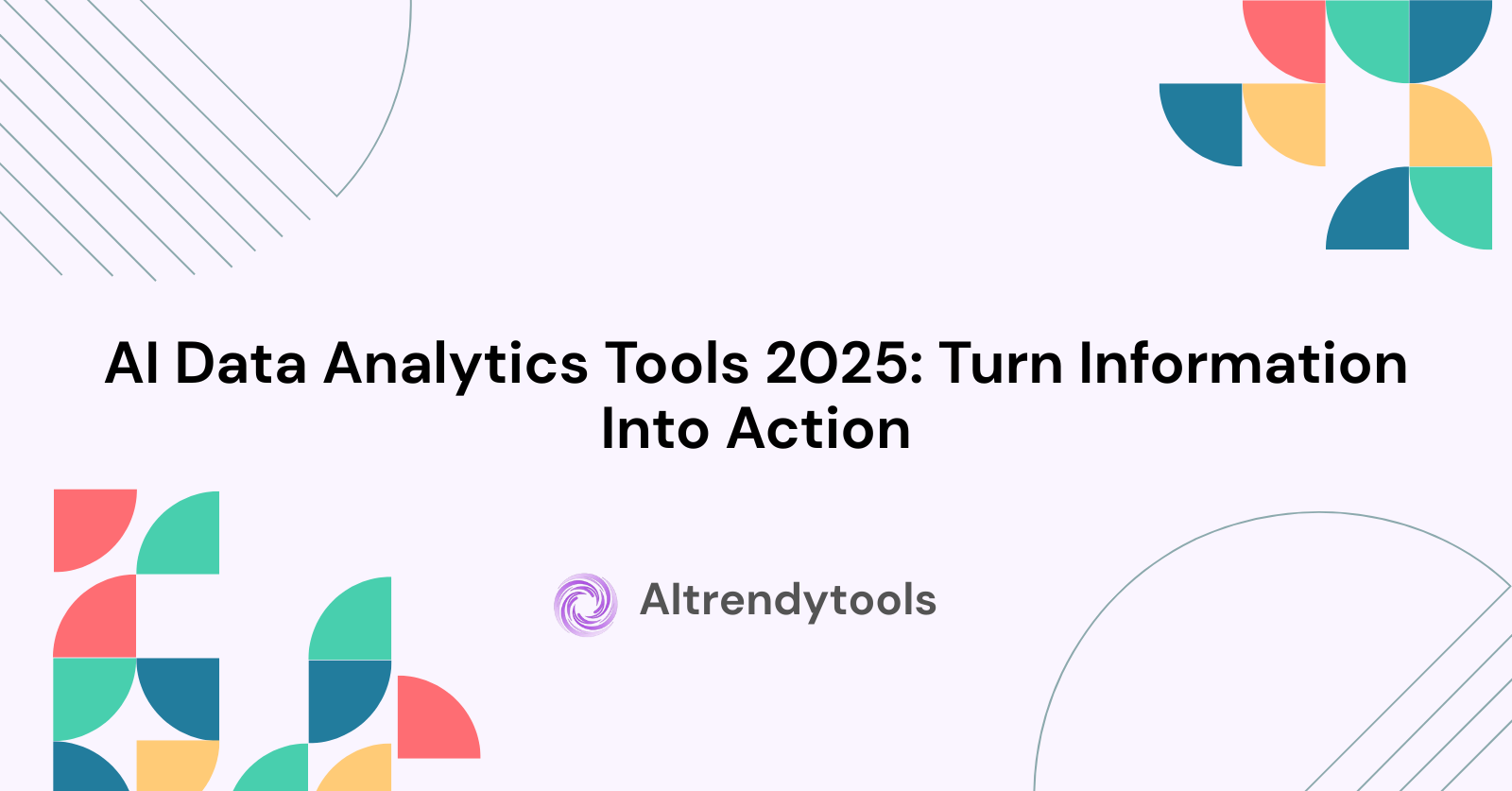🔥 AITrendytools: The Fastest-Growing AI Platform |
Write for usAI Data Analytics Tools 2025: Turn Information Into Action
Discover powerful AI data analytics tools that transform raw information into actionable insights. Learn machine learning, predictive analytics & more.
Sep 15, 2025
Data drives every successful business decision in today's competitive marketplace. Organizations generate massive amounts of information daily, but raw data alone provides little value without proper analysis and interpretation. Artificial intelligence revolutionizes how companies extract meaningful insights from complex datasets.
AI-powered data analytics tools transform overwhelming information streams into clear, actionable intelligence. These advanced systems identify patterns humans might miss while processing data at speeds impossible through manual analysis. Smart algorithms uncover hidden relationships between variables that drive business outcomes.
Modern businesses face increasing pressure to make faster, more accurate decisions based on reliable data insights. Traditional analytics methods struggle with the volume, velocity, and variety of contemporary data sources. AI solves these challenges by automating complex analytical processes while improving accuracy and speed.
The integration of machine learning algorithms with data analytics creates powerful platforms that learn and improve over time. These systems adapt to changing data patterns, ensuring analysis remains relevant and accurate. Organizations implementing AI analytics gain significant competitive advantages through improved decision-making capabilities.
Machine Learning Analytics Fundamentals
Machine learning transforms data analytics by enabling systems to automatically identify patterns and make predictions without explicit programming. Algorithms learn from historical data to recognize trends, anomalies, and relationships that inform future decisions. This automated learning process dramatically improves analytical accuracy and efficiency.
Supervised learning algorithms use labeled training data to predict outcomes for new, unseen information. These models excel at classification tasks like customer segmentation or fraud detection. Regression models predict numerical values such as sales forecasts or price optimization recommendations.
Unsupervised learning discovers hidden patterns in unlabeled data without predetermined target variables. Clustering algorithms group similar data points to reveal natural segments within customer bases or product categories. Association rule mining identifies relationships between different variables or events.
Key Machine Learning Techniques:
- Decision trees for clear, interpretable business rules
- Neural networks for complex pattern recognition
- Random forests for improved prediction accuracy
- Support vector machines for classification problems
- K-means clustering for market segmentation
Reinforcement learning optimizes decision-making through trial and error interactions with data environments. These algorithms continuously improve performance by learning from outcomes and adjusting strategies accordingly. Applications include dynamic pricing, recommendation systems, and resource allocation optimization.
Predictive Analytics Tools and Platforms
Predictive analytics leverages historical data and statistical algorithms to forecast future outcomes with measurable accuracy. These tools help organizations anticipate customer behavior, market trends, and operational challenges before they impact business performance. Advanced predictive models reduce uncertainty and enable proactive decision-making.
Modern predictive analytics platforms integrate multiple data sources to create comprehensive forecasting models. Cloud-based solutions provide scalable computing power for processing large datasets while maintaining cost efficiency. Automated model selection and hyperparameter tuning democratize access to advanced analytics capabilities.
Real-time predictive analytics enables immediate responses to changing conditions and emerging opportunities. Streaming data processing allows organizations to adjust strategies based on current information rather than historical reports. This responsiveness provides significant competitive advantages in fast-moving markets.
Leading Predictive Analytics Platforms:
- IBM SPSS for statistical analysis and modeling
- SAS Advanced Analytics for enterprise-scale predictions
- Microsoft Azure Machine Learning for cloud-based forecasting
- Google Cloud AI Platform for scalable model deployment
- Tableau with integrated predictive capabilities
Model validation and performance monitoring ensure predictive analytics maintain accuracy over time. A/B testing frameworks compare model predictions against actual outcomes to identify improvement opportunities. Continuous monitoring alerts analysts when model performance degrades due to changing data patterns.
Business Intelligence AI Integration
Business intelligence platforms enhanced with artificial intelligence deliver deeper insights and automated reporting capabilities. AI algorithms analyze business metrics, identify trends, and generate executive summaries without manual intervention. These smart dashboards highlight critical information requiring immediate attention.
Natural language processing enables business users to query data using conversational interfaces. Ask questions in plain English and receive immediate answers backed by comprehensive data analysis. This accessibility removes technical barriers that previously limited data exploration to specialized analysts.
Automated insight generation discovers meaningful patterns and correlations within business data. AI systems continuously monitor key performance indicators to identify anomalies, opportunities, and threats. Alert systems notify stakeholders when metrics exceed predefined thresholds or display unusual behavior patterns.
AI-Enhanced BI Capabilities:
- Automated report generation and distribution
- Anomaly detection for early warning systems
- Natural language query processing
- Smart data visualization recommendations
- Predictive dashboard updates
Intelligent data storytelling transforms complex analytics into compelling narratives for executive audiences. AI systems identify the most important findings and present them through clear visualizations and explanations. This approach improves communication between technical analysts and business decision-makers.
Data Science Automation Platforms
Automated machine learning platforms democratize data science by enabling business analysts to build sophisticated models without extensive programming knowledge. These tools handle complex tasks like feature engineering, algorithm selection, and hyperparameter optimization automatically. Drag-and-drop interfaces make advanced analytics accessible to non-technical users.
AutoML platforms significantly reduce the time required to develop and deploy predictive models. What previously took data scientists weeks or months can now be accomplished in days or hours. This acceleration enables organizations to respond quickly to market changes and emerging opportunities.
Model interpretability features help business users understand how AI algorithms reach their conclusions. Explanation tools identify which variables most influence predictions and provide confidence scores for individual forecasts. This transparency builds trust and enables informed decision-making based on AI recommendations.
Popular AutoML Platforms:
- H2O.ai for open-source automated machine learning
- DataRobot for enterprise model deployment
- RapidMiner for visual workflow development
- Alteryx for data preparation and analytics automation
- Google AutoML for cloud-based model building
Automated feature engineering discovers optimal data transformations and combinations for improved model performance. These systems test thousands of potential features to identify the most predictive variables. Advanced platforms even generate new features through mathematical operations and statistical transformations.
Real-Time Analytics and Streaming Data
Real-time analytics processes data as it arrives, enabling immediate responses to changing conditions and emerging opportunities. Streaming data platforms handle continuous information flows from sensors, social media, financial markets, and customer interactions. This immediacy provides significant advantages in time-sensitive decision-making scenarios.
Event processing engines analyze streaming data to detect patterns, anomalies, and trigger conditions in real-time. Complex event processing identifies meaningful sequences and correlations within high-velocity data streams. These systems enable automatic responses to critical events without human intervention.
Edge analytics brings real-time processing closer to data sources, reducing latency and bandwidth requirements. Local processing capabilities enable instant decision-making even when network connectivity is limited. This distributed approach supports applications requiring millisecond response times.
Real-Time Analytics Applications:
- Fraud detection for financial transactions
- Supply chain optimization and logistics
- Customer experience personalization
- IoT sensor monitoring and alerts
- Trading algorithm execution
Scalable streaming architectures handle massive data volumes while maintaining processing speed and accuracy. Cloud-native platforms automatically adjust computing resources based on data velocity and complexity. This elasticity ensures consistent performance during peak demand periods.
Natural Language Processing for Data Insights
Natural language processing transforms unstructured text data into valuable business insights through automated analysis of customer feedback, social media, documents, and communications. NLP algorithms extract sentiment, topics, and key themes from massive text datasets that would be impossible to analyze manually.
Sentiment analysis reveals customer attitudes and emotions expressed in reviews, support tickets, and social media posts. Organizations use this intelligence to improve products, services, and customer experiences. Advanced sentiment models detect subtle emotional nuances and contextual meanings within text communications.
Text classification automatically categorizes documents, emails, and messages based on content and intent. These systems route customer inquiries to appropriate departments, prioritize support tickets, and organize knowledge bases. Automated classification saves time while improving response accuracy and customer satisfaction.
NLP Analytics Capabilities:
- Entity extraction for identifying people, places, and organizations
- Topic modeling for discovering themes in document collections
- Language translation for global data analysis
- Keyword extraction for content optimization
- Summarization for executive reporting
Named entity recognition identifies specific items like product names, locations, and organizations within text data. This information enables detailed analysis of customer preferences, market trends, and competitive intelligence. Advanced NLP models understand context and relationships between different entities.
Data Visualization and AI-Powered Dashboards
AI-enhanced data visualization platforms automatically select optimal chart types and visual representations based on data characteristics and analytical objectives. Smart visualization engines understand which visual formats best communicate specific types of insights to target audiences. This automation ensures effective information presentation without requiring design expertise.
Intelligent dashboards adapt their content and layout based on user roles, preferences, and current priorities. Personalization algorithms learn from user interactions to surface the most relevant information and hide less important details. Dynamic dashboards update automatically as new data becomes available.
Augmented analytics combines human intuition with AI capabilities to generate deeper insights through interactive visualization. Users explore data through natural gestures and voice commands while AI suggests relevant analysis directions. This collaboration amplifies human analytical capabilities rather than replacing them.
Advanced Visualization Features:
- Automatic chart type selection and optimization
- Interactive drill-down and filtering capabilities
- Mobile-responsive dashboard designs
- Real-time data refresh and updates
- Collaborative annotation and sharing tools
Narrative generation transforms complex visualizations into clear, written explanations of key findings and trends. AI systems identify the most important insights within charts and graphs, then generate executive summaries in plain language. This capability bridges the gap between technical analysis and business communication.
Cloud-Based Analytics Solutions
Cloud analytics platforms provide scalable, cost-effective infrastructure for processing massive datasets without significant upfront hardware investments. These solutions automatically adjust computing resources based on workload demands, ensuring optimal performance while controlling costs. Organizations pay only for resources they actually use.
Multi-cloud strategies prevent vendor lock-in while optimizing performance and costs across different cloud providers. Analytics workloads can be distributed based on specific requirements, data locations, and pricing considerations. This flexibility ensures organizations maintain control over their analytical infrastructure.
Cloud-native analytics tools integrate seamlessly with other cloud services like data storage, security, and monitoring systems. Pre-built connectors eliminate complex integration projects while ensuring data flows smoothly between different platforms. These integrations accelerate deployment and reduce maintenance overhead.
Cloud Analytics Advantages:
- Elastic scaling for varying workload demands
- Reduced infrastructure management overhead
- Global accessibility for distributed teams
- Integrated security and compliance features
- Rapid deployment and time-to-value
Serverless analytics eliminate infrastructure management entirely, allowing organizations to focus on insights rather than system administration. These platforms automatically handle scaling, security updates, and performance optimization. Data scientists can concentrate on analysis without worrying about underlying technical complexities.
Industry-Specific AI Analytics Applications
Healthcare analytics leverage AI to improve patient outcomes through predictive modeling, drug discovery, and operational optimization. Machine learning algorithms analyze medical records, imaging data, and genetic information to identify treatment opportunities and risk factors. These insights enable personalized medicine and preventive care strategies.
Financial services apply AI analytics for fraud detection, risk assessment, and algorithmic trading. Advanced models analyze transaction patterns, market data, and customer behavior to identify suspicious activities and investment opportunities. Regulatory compliance monitoring ensures adherence to complex financial regulations through automated oversight.
Retail organizations use AI analytics for demand forecasting, price optimization, and customer personalization. Predictive models anticipate consumer preferences and inventory requirements while recommendation engines drive sales through targeted product suggestions. Supply chain analytics optimize logistics and reduce operational costs.
Sector-Specific Applications:
- Manufacturing: Predictive maintenance and quality control
- Energy: Grid optimization and demand forecasting
- Transportation: Route optimization and fleet management
- Agriculture: Crop yield prediction and resource optimization
- Education: Student performance analysis and personalized learning
Marketing analytics measure campaign effectiveness, customer lifetime value, and attribution across multiple channels. AI algorithms optimize advertising spend, target audience segmentation, and content personalization. These insights drive higher conversion rates and improved return on marketing investments.
Implementation Best Practices and Strategies
Successful AI analytics implementation begins with clear business objectives and success metrics. Organizations must define specific problems they want to solve and establish measurable outcomes for evaluating project success. This foundation ensures analytics initiatives align with strategic business goals.
Data quality assessment and preparation consume significant time and resources in analytics projects. Organizations need comprehensive data governance programs that ensure accuracy, completeness, and consistency across all data sources. Clean, well-structured data provides the foundation for reliable analytical insights.
Cross-functional teams combining business expertise, technical skills, and domain knowledge deliver the most successful analytics implementations. Business stakeholders provide context and requirements while technical teams handle infrastructure and modeling. This collaboration ensures solutions address real business needs effectively.
Implementation Success Factors:
- Executive sponsorship and organizational commitment
- Phased rollout with quick wins and measurable results
- Continuous user training and change management
- Regular model performance monitoring and updates
- Integration with existing business processes and systems
Change management programs help organizations adapt to AI-driven decision-making processes. Training programs ensure users understand how to interpret and act on analytical insights. Cultural transformation often requires time and patience as teams learn to trust and leverage AI recommendations.
The future of AI in data analytics promises even more sophisticated capabilities through advances in artificial intelligence research and computing power. Automated insight discovery will evolve to provide increasingly nuanced and contextual recommendations. Organizations that embrace these technologies will gain substantial competitive advantages through improved decision-making speed and accuracy.
Democratization of advanced analytics continues as tools become more accessible to business users without technical backgrounds. Natural language interfaces and automated machine learning platforms enable domain experts to perform sophisticated analysis independently. This trend accelerates analytical adoption across entire organizations.
Integration between AI analytics and operational systems will become seamless, enabling automatic execution of recommended actions. Closed-loop systems will implement optimization decisions without human intervention while maintaining appropriate oversight and control mechanisms. This automation drives significant efficiency improvements and competitive advantages.
AI in data analytics represents a fundamental shift in how organizations extract value from information assets. Companies that successfully implement these technologies transform raw data into competitive advantages through faster, more accurate decision-making. The tools and strategies outlined above provide a roadmap for organizations beginning their AI analytics journey.
Investment in AI analytics capabilities requires careful planning, adequate resources, and organizational commitment to change management. However, the potential returns through improved efficiency, reduced costs, and enhanced competitive positioning justify the effort required for successful implementation. Organizations that delay adoption risk falling behind competitors who leverage these powerful analytical capabilities.
🚀 Submit Your Tool to Our Comprehensive AI Tools Directory
Get your AI tool featured on our complete directory at AITrendytools and reach thousands of potential users. Select the plan that best fits your needs.





Join 30,000+ Co-Founders
Related Blogs
Sci Hub: 10+ Free Alternatives to Access Research Papers
Discover Sci Hub alternatives and 10+ legal ways to access research papers free. Complete guide to scientific journals, open access, and academic resources.
Picverse AI Review: Create Stunning Images in Seconds
Discover how Picverse AI transforms text into stunning visuals. Features, pricing, pros & cons everything you need to know about this AI image generator.
Fox News Guide: Top Shows, Streaming & Schedule
Discover everything about Fox News: how to watch live, popular shows like Hannity, streaming options, schedules, and anchors. Your complete guide to America's leading news network.
Submit Your Tool to Our Comprehensive AI Tools Directory
List your AI tool on AItrendytools and reach a growing audience of AI users and founders. Boost visibility and showcase your innovation in a curated directory of 30,000+ AI apps.





Join 30,000+ Co-Founders

